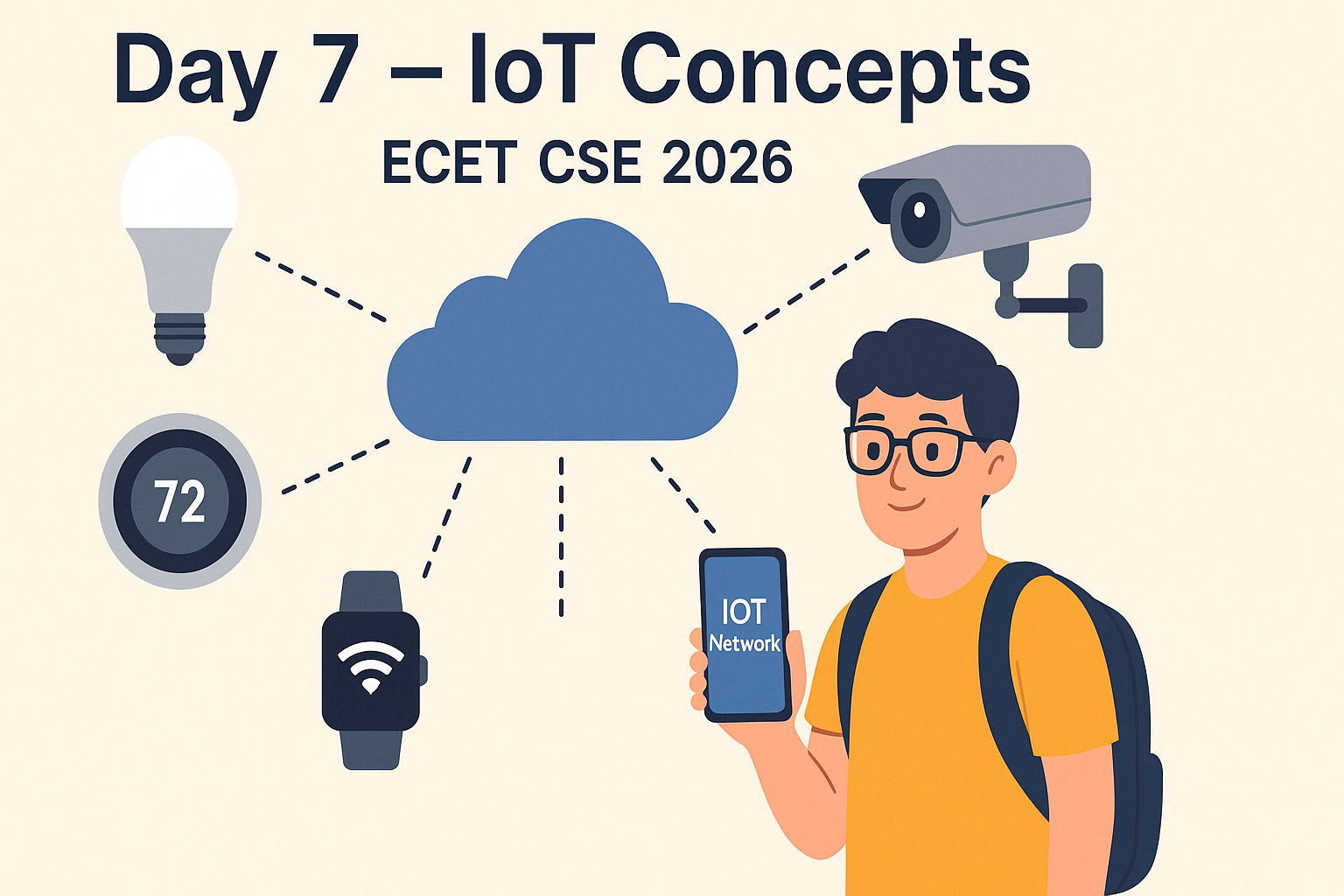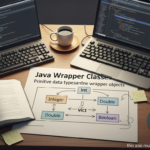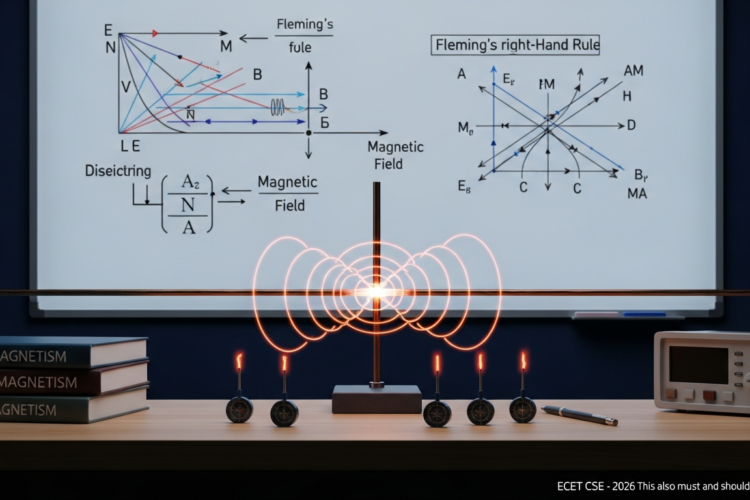
IoT Concepts – Notes & Overview
🔹 1. What is IoT?
Internet of Things (IoT) is a network of physical devices embedded with sensors, software, and connectivity to exchange data with other systems or devices over the Internet.
These “things” can include:
- Smart Home Devices (lights, fans, locks)
- Wearable Gadgets (Fitbit, smartwatches)
- Industrial Sensors
- Smart Cars
- Health Monitoring Devices
🔹 2. Real-Life Example of IoT
Imagine a smart refrigerator that:
- Senses when milk is low
- Sends a notification to your phone
- Automatically adds it to your shopping list
This is IoT in action — combining sensors, software, and the internet.
🔹 3. Key Components of IoT
| Component | Description |
|---|---|
| Device/Thing | Physical object with sensors (e.g., smart bulb) |
| Sensor | Captures data like temperature, motion, light |
| Connectivity | Transfers data via Wi-Fi, Bluetooth, Zigbee, 4G/5G |
| Data Processor | Receives and processes data (cloud/computer) |
| User Interface | Mobile app or dashboard to interact with the system |
🔹 4. IoT Architecture (4-Layered)
| Layer | Description |
|---|---|
| Perception Layer | Physical layer – sensors & actuators to detect data |
| Network Layer | Transfers data using networks like Wi-Fi, 4G, Zigbee |
| Processing Layer | Data is analyzed – stored on cloud or local systems |
| Application Layer | Delivers services (like notifications, automation) to the user |
🔹 5. Common Communication Protocols in IoT
| Protocol | Use Case |
|---|---|
| MQTT | Lightweight messaging protocol |
| HTTP | Web-based communication |
| CoAP | For constrained (low-power) devices |
| Bluetooth | Short-range device communication |
| Zigbee | Low-power, mesh network for IoT |
🔹 6. Top IoT Applications
🏠 Smart Homes:
- Smart lights, thermostats, locks, cameras
- Controlled using mobile apps or voice assistants (Alexa, Google Assistant)
🚗 Smart Vehicles:
- GPS tracking, automatic driving, safety sensors
🏥 Healthcare:
- Heart rate monitors, blood sugar level tracking, remote patient monitoring
🏢 Industrial IoT (IIoT):
- Machine monitoring, predictive maintenance, energy optimization
🌱 Agriculture:
- Soil moisture sensors, automated irrigation, weather tracking
🔹 7. Benefits of IoT
✅ Real-time Monitoring
✅ Automation & Efficiency
✅ Reduced Human Effort
✅ Energy Savings
✅ Predictive Maintenance
✅ Better Decision Making with Data
🔹 8. Challenges in IoT
❌ Security Threats
❌ Data Privacy
❌ Complex Integration
❌ High Cost of Deployment
❌ Network Dependence
🔹 9. IoT vs Internet
| Feature | Internet | Internet of Things |
|---|---|---|
| Used For | Sending emails, browsing | Controlling devices, collecting sensor data |
| Devices | Laptops, Phones | Sensors, microcontrollers, smart devices |
| Interaction | Human-Human/Computer | Device-to-Device (Machine-to-Machine) |
🔹 10. Microcontrollers Used in IoT
| Controller | Description |
|---|---|
| Arduino | Open-source, beginner-friendly board |
| ESP8266 | Wi-Fi-enabled microcontroller |
| Raspberry Pi | Mini-computer for IoT & ML projects |
🔹 11. Cloud Platforms for IoT
| Platform | Features |
|---|---|
| AWS IoT Core | Connects billions of devices |
| Google Cloud IoT | Scalable platform for analytics |
| Microsoft Azure IoT | Real-time dashboards, alerts |
🔹 12. Real-Time Example (Use Case Flow)
💡 Let’s say you install a Smart Fan in your room:
- Fan detects room temperature via sensor (Perception Layer)
- Sends temperature data to the cloud via Wi-Fi (Network Layer)
- Cloud checks if it exceeds 30°C (Processing Layer)
- Fan turns ON automatically, and you get a notification (Application Layer)
🧠 Top 10 MCQs – IoT Concepts
1️⃣ What does IoT stand for?
A) Input of Technology
B) Internet of Tools
C) Internet of Things
D) Innovation of Things
2️⃣ Which layer in IoT includes sensors and actuators?
A) Network Layer
B) Application Layer
C) Perception Layer
D) Cloud Layer
3️⃣ Which communication protocol is commonly used in low-power IoT devices?
A) HTTP
B) FTP
C) MQTT
D) SMTP
4️⃣ Which is NOT a use case of IoT?
A) Smart lights
B) Online games
C) Health monitoring
D) Smart irrigation
5️⃣ ESP8266 is a type of:
A) Sensor
B) Router
C) Microcontroller
D) Switch
6️⃣ What is the full form of MQTT?
A) Machine Query Transfer Technique
B) Message Queuing Telemetry Transport
C) Mobile Quick Transfer Technology
D) Micro Quality Transfer Tool
7️⃣ Which layer is responsible for sending notifications to users?
A) Perception Layer
B) Network Layer
C) Processing Layer
D) Application Layer
8️⃣ Which of these is an IoT challenge?
A) Real-time feedback
B) Low cost
C) High security
D) Privacy issues
9️⃣ Smartwatches that monitor heart rate are part of:
A) Smart Agriculture
B) Industrial IoT
C) Wearable IoT
D) Smart Grid
🔟 Which cloud platform supports IoT deployments?
A) Canva
B) AWS
C) Instagram
D) Spotify
✅ Answer Key
| Q.No | Answer |
|---|---|
| 1 | C |
| 2 | C |
| 3 | C |
| 4 | B |
| 5 | C |
| 6 | B |
| 7 | D |
| 8 | D |
| 9 | C |
| 10 | B |
📖 Explanations
- Q1: IoT = Internet of Things
- Q2: Sensors are in Perception Layer
- Q3: MQTT is a lightweight protocol used in IoT
- Q4: Online games are not considered an IoT function
- Q5: ESP8266 is a Wi-Fi based microcontroller
- Q6: MQTT → Message Queuing Telemetry Transport
- Q7: Application layer delivers results to users
- Q8: IoT faces privacy and security risks
- Q9: Wearable IoT = Smartwatches, fitness bands
- Q10: AWS, Azure, Google Cloud are used in IoT hosting
📥 Download PDF
📝 All Notes + 10 MCQs + Answers + Explanation available as free PDF at
👉 @learnnewthingsoffcial
💬 Comment Task
💬 What smart device do you use at home (if any)? Drop it in comments and we’ll show how it works in IoT architecture!



